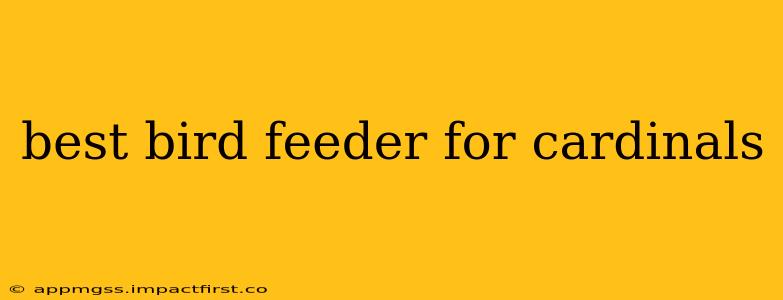Cardinals, with their vibrant red plumage (males) and charming demeanor, are a delight to any birdwatcher. Attracting these beautiful birds to your backyard requires the right equipment, and choosing the right bird feeder is key. This guide explores the best types of feeders for cardinals, addressing common questions and providing expert advice to help you create a cardinal-friendly haven.
What Kind of Bird Feeder Do Cardinals Like?
Cardinals prefer feeders that offer easy access to larger seeds, like sunflower seeds and safflower seeds, their favorites. They aren't particularly fond of intricate designs or feeders requiring complex maneuvers. Therefore, simple, sturdy feeders that are easy to perch on and feed from are ideal.
What is the Best Type of Bird Feeder for Cardinals?
Several feeder types excel at attracting cardinals:
-
Platform Feeders: These are arguably the best option. Their open design allows cardinals easy access to seeds without competition from smaller, more agile birds. The large, flat surface provides ample space for multiple cardinals to feed simultaneously. Look for platform feeders that are relatively shallow to prevent seed waste.
-
Tube Feeders (with large perches): While tube feeders are popular, cardinals may struggle with some designs. Opt for tube feeders with wide perches capable of supporting their weight comfortably. Large seed openings are also crucial for easy access.
-
Hopper Feeders (with wide openings): Hopper feeders can work well, provided they have wide openings at the bottom, allowing cardinals to easily access the seeds without difficulty. Again, look for sturdy perches.
Avoid feeders with small perches or intricate designs that might hinder cardinals from feeding comfortably.
What Size Bird Feeder Is Best for Cardinals?
There isn't a specific size that universally works best, but generally, larger feeders are preferable. A larger feeding area reduces competition and allows multiple cardinals to feed simultaneously, increasing their comfort and attracting more of them. However, ensure the size is appropriate for your space and the quantity of seed you wish to provide.
What Kind of Seeds Do Cardinals Like Best?
Sunflower seeds (black oil sunflower seeds are best) are a cardinal favorite. They're high in energy and readily available. Safflower seeds are another excellent choice, offering a nutritious alternative that some smaller birds find less appealing, thus reducing competition for cardinals. Avoid cracked corn, as it’s less nutritious and often attracts unwanted pests.
How High Should a Cardinal Feeder Be?
The ideal height depends on your yard's layout and the presence of other plants and structures. Generally, placing the feeder between 4 and 6 feet off the ground is a good starting point. This height provides a sense of security for the cardinals while still being easily accessible for them. Consider the surrounding vegetation—positioning near bushes or trees can provide additional cover and protection.
How to Keep Squirrels Away From Cardinal Feeders?
Squirrels are notorious for raiding bird feeders. To deter them, consider these options:
-
Squirrel-resistant feeders: These feeders feature designs that make it difficult for squirrels to access the seeds. However, persistent squirrels can sometimes overcome even the most sophisticated designs.
-
Baileys Squirrel Baits: This product is specially designed to attract squirrels. Place it away from your feeder so they have another source of food.
-
Strategic placement: Place the feeder in a location where it’s less accessible to squirrels, such as away from tree branches or fences they can easily jump to.
By implementing these strategies, you can significantly reduce squirrel interference.
Best Place to Put a Cardinal Feeder?
Ideally, place your feeder near shrubs or trees, providing cardinals with protection from predators. Ensure the feeder is visible to cardinals and away from direct sunlight and rain. A sheltered spot helps keep the seeds dry and prevents them from spoiling quickly. Consider the proximity to windows to avoid potential collisions.
By carefully considering the type of feeder, seed selection, and placement, you can significantly increase your chances of attracting these striking birds to your backyard and enjoying their presence. Happy birdwatching!
